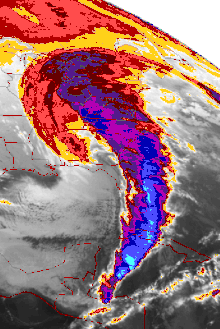 | |
| Meteorological history | |
|---|---|
| Formed | March 12, 1993 |
| Dissipated | March 14, 1993 |
| Category 5 "Extreme" winter storm | |
| Regional Snowfall Index: 24.63 (NOAA) | |
| Highest winds | 100 mph (160 km/h) |
| Lowest pressure | 960 mbar (hPa); 28.35 inHg |
| Lowest temperature | −12 °F (−24 °C) |
| Maximum snowfall or ice accretion | 56 in (140 cm) at Mt. Le Conte, Tennessee |
| Tornado outbreak | |
| Tornadoes | 11 |
| Maximum rating | F2 tornado |
| Duration | 1 hour, 32 minutes |
| Overall effects | |
| Fatalities | 318 |
| Damage | $5.5 billion (1993 USD) |
| Areas affected | Eastern United States, Canada, Mexico, Cuba, The Bahamas, Bermuda |
| Power outages | >10,000,000 |
Part of the 1992–93 North American winter and tornado outbreaks of 1993 | |
The 1993 Storm of the Century (also known as the 93 Superstorm, The No Name Storm, or the Great Blizzard of '93/1993) was a cyclonic storm, or nor'easter, that formed over the Gulf of Mexico on March 12, 1993. The cold weather, heavy snowfall, high winds and storm surges that the storm brought affected a very large area; at its height, it stretched from Canada to Honduras.[1] The cyclone moved through the Gulf of Mexico and then through the eastern United States before moving on to eastern Canada. It eventually dissipated in the North Atlantic Ocean on March 15.
Heavy snow was first reported in highland areas as far south as Alabama and northern Georgia, with Union County, Georgia reporting up to 35 inches (89 cm) of snow. Birmingham, Alabama, reported a rare 13 in (33 cm) of snow.[2][3] The Florida Panhandle reported up to around 6 inches to a foot of snow,[4] with hurricane-force wind gusts and record low barometric pressures. Between Louisiana and Cuba, the hurricane-force winds produced high storm surges across the Big Bend of Florida which, in combination with scattered tornadoes, killed dozens of people.
Record cold temperatures were seen across portions of the Southern United States and Eastern United States in the wake of this storm. In the United States, the storm was responsible for the loss of electric power to more than 10 million households. An estimated 40 percent of the country's population experienced the effects of the storm[5] and it led to a total of 208 fatalities.[1] In all, the storm resulted in 318 deaths, and caused $5.5 billion (1993 USD) in damages.
The greatest recorded snowfall amounts were at Mount Le Conte in Tennessee, where 56 inches (140 cm) of snow fell, and Mount Mitchell in North Carolina, the tallest mountain in eastern North America, where 50 inches (130 cm) were measured to fall and 15-foot (4.6 m) snow drifts were reported.[6]
- ^ a b Armstrong, Tim. "Superstorm of 1993: "Storm of the Century"". NOAA. Retrieved February 12, 2017.
- ^ "Birmingham Cold Weather Facts (updated Nov. 24, 2015)". National Weather Service-Birmingham. Retrieved February 12, 2017.
- ^ "21 years ago, Atlanta slammed by rare blizzard". ajc.com. March 13, 2013.
- ^ National Climatic Data Center (1993). "Event Details". National Oceanic and Atmospheric Administration. Archived from the original on April 16, 2009. Retrieved December 22, 2010.
- ^ Cite error: The named reference
assessmentwas invoked but never defined (see the help page). - ^ "On This Day: The 1993 Storm of the Century". National Centers for Environmental Information (NCEI). March 9, 2017. Retrieved October 19, 2020.